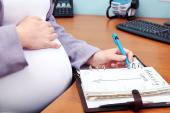Expert Consensus Advocates for Normalizing Pregnancy in Cath Labs
The literature shows no evidence to justify the strict radiation thresholds some countries insist upon for pregnant operators.

Pregnant interventional cardiologists and staff should be allowed to continue to work safely in a cath lab environment, provided that ionizing radiation doses to the fetus do not exceed accepted levels, a new statement from several physician societies concludes.
“The aim of this statement is to eliminate one cause of gender inequity in invasive cardiology subspecialities,” lead author Stéphane Manzo-Silberman, MD (Sorbonne Université, Paris, France), told TCTMD via email.
Although data on the risks of prenatal radiation are scarce, the existing evidence reviewed in the document supports the contention that thresholds encountered in cath lab work, as measured by a radiation badge worn under a lead apron at waist level, are well below the limits that have been associated with fetal harm at any stage of pregnancy.
As the authors note in the paper published in EuroIntervention, radiation exposure is a hot button topic in interventional cardiology, having been identified in surveys such as one conducted by the Women in Cardiology (WIC) section of the American College of Cardiology as a major barrier for women considering a career in the field.
While most countries allow pregnant workers to continue in their job as long as they wear the abdominal dosimeter, others such as Austria, Hungary, and Italy have laws or government decrees that prevent workers from being in catheterization or electrophysiology labs while pregnant or even while breastfeeding.
In countries that do allow work in cath labs while pregnant, permissible levels of radiation exposure are wildly divergent, from 5 mSv or less during the entire pregnancy (or 0.5 mSv per month) in the United States, to 1 mSv or less during pregnancy in several European countries, Manzo-Silberman and colleagues note. Those thresholds go into place when workers inform their institution that they are pregnant.
The new document, which was written by the European Association of Percutaneous Cardiovascular Interventions (EAPCI) in collaboration with the European Heart Rhythm Association (EHRA), the European Association of Cardiovascular Imaging (EACVI), the ESC Regulatory Affairs Committee, and Women as One, sought to “promote awareness at both the local and national levels to ensure a level playing field and a friendly environment for all, including pregnant interventionists,” said Manzo-Silberman.
‘No Practical Significance’ of Prenatal Exposure
In the statement, the experts note that with no RCTs assessing prenatal radiation risk, the most conclusive studies in the literature have involved pregnant individuals exposed to “massive radiation exposure such as after the atomic bombs used in World War II.” Another category of data on prenatal radiation exposure comes exclusively from population estimates. Among the high-quality data that do exist, none show any increased risk of noncancerous effects from prenatal radiation exposure below a threshold of 50 mSv, the expert consensus concluded.
If during an interview the question of [family planning] was or is regularly asked of all female candidates, this question either must be deleted—because it falls within the private sphere—or be asked of all candidates so that it is for the purpose of support and facilitation and not discrimination. Stéphane Manzo-Silberman
Overall, the literature suggests that occupational exposure of < 5 mSv would be “of no practical significance,” in terms of fetal harm up to 25 weeks of pregnancy, the document notes. For those working in the third trimester, the lifetime cancer risk of the fetus is estimated to be one in 500 for 5 mSv in utero exposure and one in 2,500 for 1 mSv in utero exposure, or similar to the risk following radiation in early childhood.
For any pregnancy occurring in the general population, there is a 4% risk of spontaneous congenital malformations, which would be increased to 4.01% in cath lab workers with 5 mSv of cumulative exposure. Similarly, the generalized risk for all pregnancies of a childhood cancer is 0.07%, which increases to 0.11% with 5 mSv of occupational radiation exposure, the document states.
Just as important as the exposure during the pregnancy is the awareness of everyday occupational exposure prior to becoming pregnant. Manzo-Silberman and colleagues encourage operators to measure radiation exposure prior to pregnancy in order to estimate the likely occupational risk during pregnancy. “Since the first trimester is when the conceptus is at highest risk to radiation exposure and since most women may not know they are pregnant during this time, it is important to practice universal radiation safety at all times,” they add.
Normalizing Pregnancy in the Cath Lab and Beyond
According to the document, the widespread differences in what countries set as their occupational radiation exposure threshold in pregnancy versus what others allow and what is realistic will require interventional and electrophysiology societies of countries that currently have very low thresholds “to work together with their national health system authorities to promote changes in regulation and to repeal sexist laws that disincentivize women to choose interventional subspecialities.” Another reason why this is an urgent concern, Manzo-Silberman said, is that unnecessarily strict thresholds can lead to late pregnancy declarations by operators to their hospitals, which may pose unnecessary risks to the fetus.
When operators are working while pregnant, they don’t have the benefit of wearing maternity protective gear for the cath lab because it does not exist, which means “it is just a matter of finding apron clothing adapted to your morphology, as any other operators, and be sure to be sufficiently covered,” Manzo-Silberman told TCTMD. The expert consensus highlights the need for lighter protective garments “to avoid additional physical burdens on pregnant women and ensure that these protection suits are adjustable as the fetus grows.”
Although the issue is primarily of concern to female operators, Manzo-Silberman said she hopes male interventional cardiologists and staff will see this document as a reminder of the need for consistent safe radiation practices for all who hope to become parents, given that chronic occupational radiation exposure in men is correlated with a higher prevalence of low birthweight and male infertility.
“Providing a better awareness and knowledge about radiation monitoring and protection is beneficial for all,” Manzo-Silberman said. “If during an interview the question of [family planning] was or is regularly asked of all female candidates, this question either must be deleted—because it falls within the private sphere—or be asked of all candidates so that it is for the purpose of support and facilitation and not discrimination.”
She added that the expert consensus group believes it is important to normalize conversations about pregnancy in interventional cardiology. One step toward doing this is to target medical school curricula and dispel fallacies about heightened risks of working while pregnant, “particularly the ones related to the impact of radiation on women’s fertility and conception,” the authors note. They advise that institutions should work on improving their radiation counselling services to address employees’ concerns and train them in best practices that minimize exposure.
L.A. McKeown is a Senior Medical Journalist for TCTMD, the Section Editor of CV Team Forum, and Senior Medical…
Read Full BioSources
Manzo-Silberman S, Velázquez M, Burgess S, et al. Radiation protection for healthcare professionals working in catheterization laboratories during pregnancy: a statement of the European Association of Percutaneous Cardiovascular Interventions (EAPCI) in collaboration with the European Heart Rhythm Association (EHRA), the European Association of Cardiovascular Imaging (EACVI), the ESC Regulatory Affairs Committee and Women as One. EuroIntervention. 2022;Epub ahead of print.
Disclosures
- Manzo-Silberman has received consulting fees from Bayer, Organon, and Exeltis; lecture fees from Bayer, BMS, Exeltis, and Organon; and has served on an adjudication board for Biotronik.





Comments